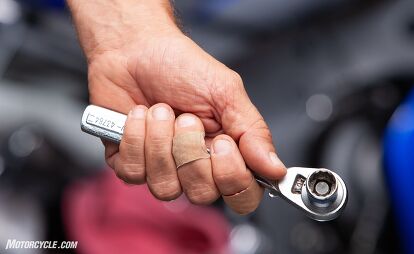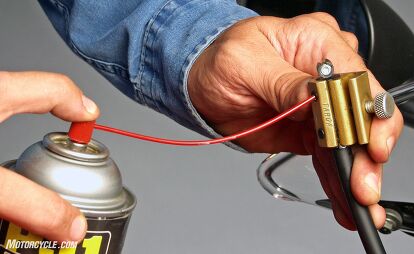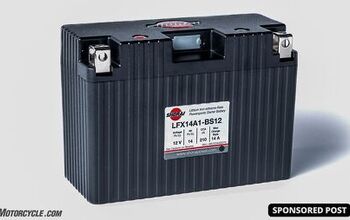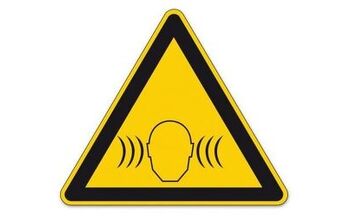Must Have Motorcycle Tools For Productive Wrenching

10 tools that will make your wrenching easier and more productive
Motorcycles seem to invite their owners to tinker with them. Maybe it’s the fact that often the components are easy to get to once the bodywork has been removed. Regardless of the reason, we, as motorcyclists, tend to maintain and modify our own machines, leaving only the most highly technical items to the mechanics at our local shop.
But what if you’re new to motorcycling? Where do you start? Most budding mechanics begin with a basic mechanics selection of tools: sockets, ratchets, open end wrenches, and a selection of pliers. If you shop carefully, you can score some good deals on quality tools. However, there are some specialized motorcycle tools that may not be readily apparent that can make your wrenching so much easier.
Read on to find out what the staff at Motorcycle.com considers to be the essential motorcycle tools in their garages.
Table of Contents
-
1. Maintenance Necessity: Front and Rear Stands: Shop Now
-
2. End Loose Fasteners: Torque Wrench: Shop Now
-
3. Secret Weapons: Ratcheting Combination Wrenches: Shop Now
-
4. Unsung Hero: Cable Luber: Shop Now
-
5. Life Saver: Smart Battery Charger: Shop Now
-
6. Secret Decoder Ring: Multimeter: Shop Now
-
7. Ingenious Accessory: Axle Tool: Shop Now
-
8. Money Saver: Chain Breaker/Riveter: Shop Now
-
9. Mess Preventer: Brake Bleeder: Shop Now
-
10. Holy Grail: Factory Service Manual: Shop Now
1. Maintenance Necessity: Front and Rear Stands
We’re happy to report that manufacturers are starting to include center stands on some standard motorcycles again. Still, many bikes don’t have them, and working on your bike is much easier when it is upright on a stand. While not all motorcycles can accommodate a rear stand, if your bike will, it is a worthwhile investment. Chain lubing will be much simpler, and the bike will be held in a much sturdier position for other maintenance chores. If you plan on doing any work that requires the front wheel be removed, you should also invest in a front stand to support the bike when it’s not wearing any shoes.
Bottom Line
- No motorcycle garage should be without stands
2. End Loose Fasteners: Torque Wrench
Yes, torque wrenches are expensive, and your dad and grandad may have claimed to never have needed one. Still, motorcycles have changed, and the manufacturing tolerances are much tighter. When you’re putting your bike back together, you’ll feel better about your work if you use the proper torque for each part. Trust us on this.
Torque wrenches are so important that they have a buyer’s guide devoted to them.
Bottom Line
- Significantly more accurate than a torque elbow
3. Secret Weapons: Ratcheting Combination Wrenches
Yes, you can get by with just a standard set of combination wrenches, but you’d be amazed at how many tight spaces that you can’t fit a standard ratchet into. Also, in spaces where you have a limited angle of rotation, some wrenches allow you to ratchet in as little as 2°. In those instances, you can save tons of time with a combination wrench that has a ratchet at one end.
Bottom Line
- These may become some of your most reached for tools
4. Unsung Hero: Cable Luber
Although cable lubers aren’t terribly expensive, they are worth their weight in gold when it’s time to lubricate your motorcycle’s cables. You simply screw the tool onto the top end of the cable, insert the tube from your can of cable lube, and give it a spritz. Once the lube bubbles out the far end of the cable, you can be comfortable with the knowledge that your cables will last a long time. Some might scoff that the lowly luber is still on this list since so many bikes come with a ride-by-wire-throttle. Still, having a smooth clutch engagement is one of the joys of motorcycling.
Bottom Line
- Will the advancement of technology knock the cable luber off the list?
5. Life Saver: Smart Battery Charger
In a perfect world, we’d ride our motorcycles every day. While a few hardy enthusiasts do, the vast majority of us have to park our bikes occasionally. For those times when our pride and joy sits for more than a few days, the longevity of its battery can be dramatically improved by using a smart battery charger. These chargers monitor the state of your bike’s battery and only actively charge it when the voltage drops below a certain level. Once the proper voltage is reached, the charger returns to float mode to keep your bike in its ideal range. Note: the chargers for standard lead-acid batteries and lithium ion batteries are different. Make sure you buy the proper charger for your bike’s battery.
Bottom Line
- Never encounter the dreaded click, click, click again
6. Secret Decoder Ring: Multimeter
From testing your battery’s voltage to troubleshooting electrical shorts, a multimeter is an essential part of your mechanics arsenal. It doesn’t need to be a big fancy one, either. You just need the basics: DC voltage, continuity, and resistance.
Bottom Line
- You'll never be able to trace that short without a multimeter
7. Ingenious Accessory: Axle Tool
For years, owners of modern sport bikes had to go buy an odd-sized allen key to enable them to remove their bike’s front wheel. Then some clever soul (bless you!) came up with the motorcycle allen tool. This tool has all of the most common hex key sizes used in front axles all in one place. Buy it. You’ll be glad you did. Note: since there are many versions of the tool on the market with different size groupings, make sure you buy one with the size you need.
Bottom Line
- One tool for multiple axles
8. Money Saver: Chain Breaker/Riveter
Most chain-driven motorcycles come with endless chains from the factory. So, you’ll need to break it before you can replace it. Then you’ll need to cut your replacement chain to length. Finally, you’ll need to spread the rivets on the new master link to finish the job. Guess what? You only need one tool. Go ahead, spend the money on a chain breaker/riveter. It’s worth every penny.
Bottom Line
- You'll never have to know the indignity of tossing a master link
9. Mess Preventer: Brake Bleeder
A vacuum hydraulic line bleeder used to be a luxury, but now with the increasingly complicated systems on ABS-equipped motorcycles, a brake bleeder is a must for the home mechanic. The brake bleeder not only saves you time, but it also can help you do a better job of getting any stray bubbles out of your bike’s hydraulic systems.
Bottom Line
- Increasingly important thanks to ABS
10. Holy Grail: Factory Service Manual
Nobody knows a motorcycle better than the engineers who created it. So, it makes sense that you buy the factory service manual for your bike. You’ll learn the proper way to disassemble and reassemble your bike like a pro. Also, any specialty tools you may need for your particular motorcycle will be listed, making it possible to buy them before your engine’s halfway apart. A factory service manual will outline all of the service intervals for your particular model. Seeing that book on the shelf with greasy fingerprints all over it will put a smile on your face.
See your local dealer for your bike’s factory service manual.
Bottom Line
- Correct information from the engineers that designed your motorcycle
FAQ
How often should I maintain my motorcycle?
The gold standard for motorcycle maintenance is the schedule listed in your bike’s owner’s manual (or better yet, the factory service manual). Generally, maintenance chores are broken down in groups. Frequent/weekly maintenance items are chain lubrication and slack test, tire pressure test/set, and pre-ride safety checks. Then you have the longer intervals, like oil changes, brake pad swaps, and valve adjustments. Again, every manufacturer outlines these intervals in the owner’s manual or factory service manual, eliminating the guesswork for the rider.
Is maintenance on a motorcycle expensive?
As with many things in life, that depends. Mostly, it depends on how much you ride your motorcycle and how you ride your motorcycle. Someone who commutes on their motorcycle racks up more miles per year and will naturally need more maintenance, like oil changes, done. Similarly, someone who spends every weekend out riding mountain roads on the stickiest tires you can buy for the street will need more frequent tire changes. Still, for an average rider, a rough estimate of $500-$1,000 per year would cover most maintenance – with the vast majority of riders being at the low end of the spectrum.
Which bike has less maintenance?
New bikes will typically have the least maintenance because they have less wear and tear. Additionally, they come with a warranty to cover any defects. If you’re looking at used motorcycles, more recent model years with low mileage are your best bet. Still, there are those rare used gems, the older, low-mileage bike out there for those who are willing to wait until they find one.
Recent Updates: September 2021: Additional resources and FAQ added
Additional Resources
We are committed to finding, researching, and recommending the best products. We earn commissions from purchases you make using the retail links in our product reviews and other articles. Learn more about how this works.
Become a Motorcycle.com insider. Get the latest motorcycle news first by subscribing to our newsletter here.

Like most of the best happenings in his life, Evans stumbled into his motojournalism career. While on his way to a planned life in academia, he applied for a job at a motorcycle magazine, thinking he’d get the opportunity to write some freelance articles. Instead, he was offered a full-time job in which he discovered he could actually get paid to ride other people’s motorcycles – and he’s never looked back. Over the 25 years he’s been in the motorcycle industry, Evans has written two books, 101 Sportbike Performance Projects and How to Modify Your Metric Cruiser, and has ridden just about every production motorcycle manufactured. Evans has a deep love of motorcycles and believes they are a force for good in the world.
More by Evans Brasfield







































Comments
Join the conversation
10mm sockets: where do they all go? Is there a box in a closet somewhere with 24,000 10mm sockets in it?
How about a review on the smallest battery jumper that can start a bike and still fit into a pocket?